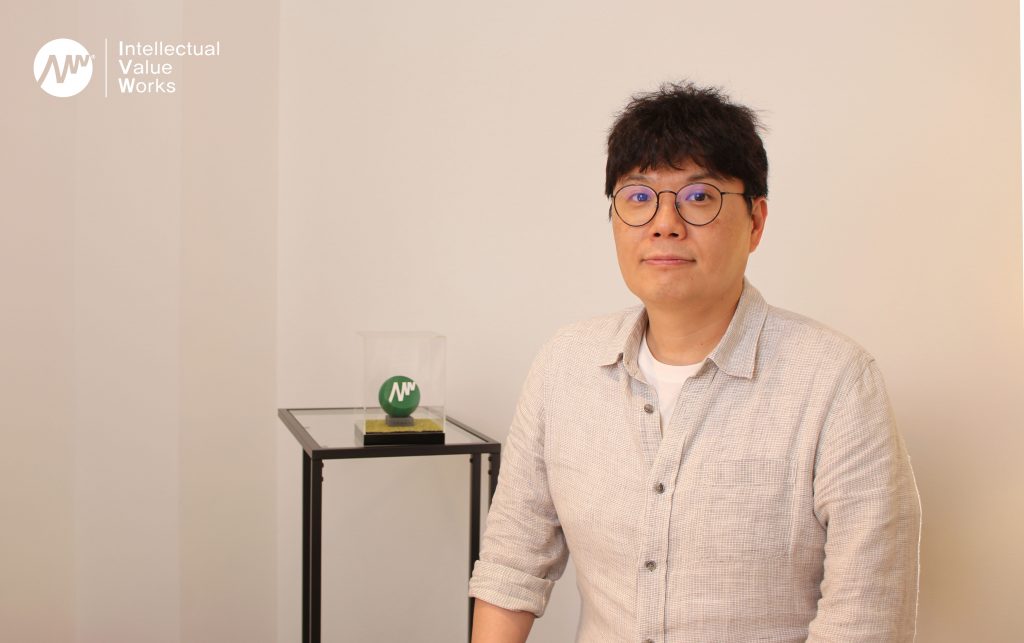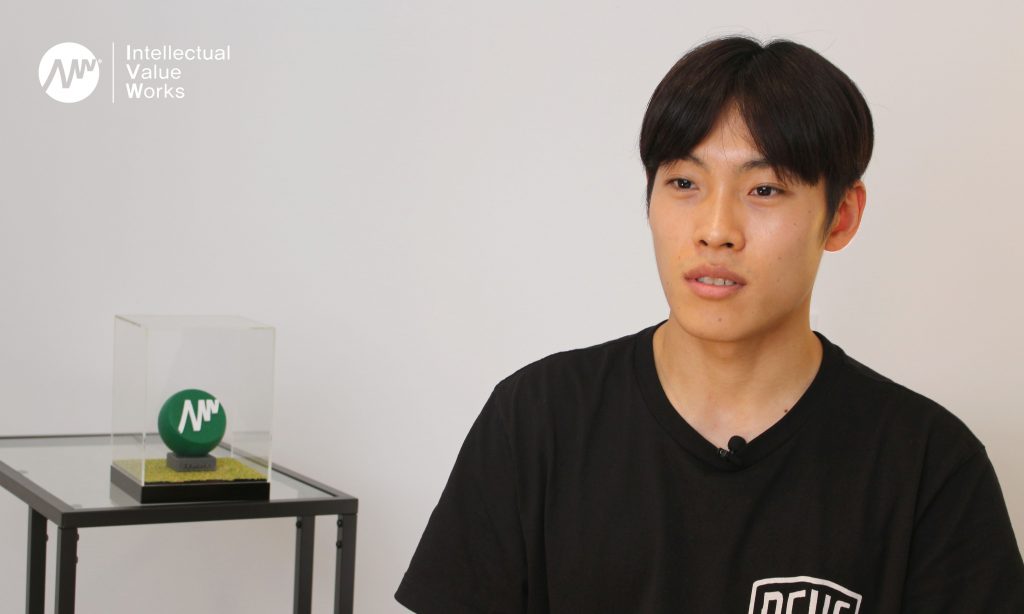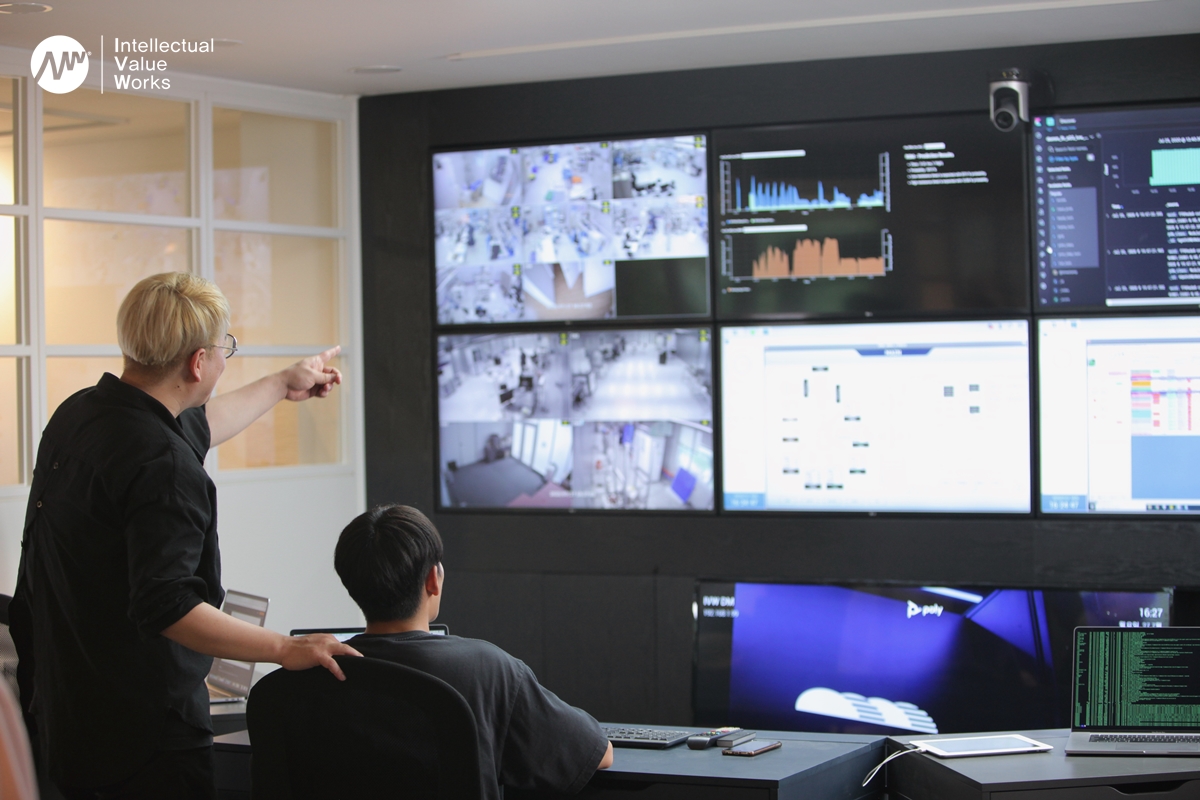news
One of the keys to the production of high-quality GaN epiwafers for IVWorks is its innovative production technology using Artificial Intelligence (AI). IVWorks improves productivity by applying AI Epitaxy DOMM™. What role does AI play in epitaxial growth? We met the AI team at IVWorks, who has been developing innovative technologies every year, and listened to their story.
Q. AI team’s role at IVWorks?
Principal Researcher Hongkyun Noh : The AI team at IVWorks collects, analyzes, and predicts data generated during the growth of compound semiconductor materials in real-time to help with mass production. We can obtain results that help mass-produce products by analyzing machine learning algorithms. We support DOMM™, which provides real-time guidance. I am in charge of overall data collection, research and development of machine learning, and applications of the system.

Q. Background on applying AI to epitaxial growth?
Principal Research Engineer Hongkyun Noh : When compound semiconductor materials, such as gallium nitride (GaN) grow, they generate two main types of data. One is video data, called RHEED, and the other is sensing data from all sorts of devices. In the case of RHEED, which is video data that can be analyzed by machine learning, it has the physical characteristic that everything that occurs during semiconductor growth is stacked in the form of time-series data. So, if you thoroughly analyze these data and apply a good algorithm to them, it becomes excellent material for determining the suitability of mass-production. The epitaxial growth process requires numerous parameters and has complex structures. In general, engineers handled all of this, but human error is inevitable in the process. To reduce this error, our team applied AI to the manufacturing of compound semiconductor materials. There is a difference in proficiency among engineers. While experienced engineers can make quick decisions and take appropriate actions by evaluating RHEED videos and sensing data, junior engineers lack the experience to make those decisions. Unfortunately, this is directly related to product quality, which can lead to a lot of defective products. Therefore, we expect that machine learning algorithms will remedy those shortcomings, improve the quality of mass production, and reduce costs.
Senior Research Engineer Byungkwon Park : If we use real time monitoring equipment, such as RHEED, we can check whether a product is in good condition or bad condition during production. It is an enormous task and physically demanding for a person to analyze time-series data coming from RHEED. We incorporate this drawback into the AI system, so that it analyzes time-series data in real time, and then, predicts results.

Q. What is the ‘novelty’ of IVWorks AI technology?
Research Engineer Taehyun Kim : The process of compound semiconductor material manufacturing is a continuation of numerous changes. These changes must be monitored and controlled in real-time. Therefore, the quality of production varies depending on the proficiency of the person who directly participates in manufacturing. Our DOMM predicts the quality of products based on a model developed by collecting a variety of sensing data and RHEED video data. Image analysis is the most advanced and proven field among artificial intelligence technologies. Generally, it is used in medical imaging, such as CT and MRI. Epitaxial growth is also a highly sophisticated and technical area. For that reason, this is considered to be a novel application of AI in the industry, as it is not easy to replicate the technology for other areas. In addition, the unique factor about DOMM is that it is the most optimized system for the company’s conditions (equipment, engineer, etc.) as it is our in-house developed technology.

Research engineer Sungkyu Lee : IVWorks collects all data that are generated during the growth of compound semiconductor materials. Data collected in real-time during semiconductor growth are analyzed by AI models in the system. This process increases product completeness and productivity and contributes significantly to lower production costs. In addition to the constructed systems, additional models studied by the AI team are also achieving positive results. Further, our study on algorithms enables AI to make a new combination of recipes on its own, which is also worth noting!
Q. How is DOMM used in the actual process?
Senior Research Engineer Byungkwon Park : Through a platform development called ‘DOMM WEB’, we have enabled engineers to access the WEB. DOMM WEB was implemented in a way in which users can directly evaluate the growth data on a screen when connected to the WEB. Within DOMM, systems, such as inference systems that predict machine learning are executed in real-time by processing a number of workflows.

Q. I’ve heard there was a recent DOMM WEB update?
Senior Research Engineer Byungkwon Park : There was an internal WEB update recently. The previous version simply processed images and displayed the results, however the latest version displays predicted results, so that a judgment of pass/fail can be determined beforehand or even during production.
Principal Research Engineer Hongkyun Noh : This is because improved machine learning algorithms have been applied in the latest update. We also made UI improvements, so that engineers, with whom this technology is actually in demand, find it more convenient to use. We also train engineers on these updates in order for them to be able to use without a hitch.
Q. What are the reactions of engineers who have used DOMM?
Principal Researcher Hongkyun Noh : Most users have shown overall satisfaction. In the past, many areas relied on an engineers’ capabilities, but our team found those areas right away and made it possible to figure them out through UI, and that might be the reason for the high satisfaction rate.
Senior Researcher Byungkwon Park : When they first encountered the technology, there was a backlash because each engineer had their own habits. However, they say that the more results accumulate and the better our predictions fit, the more helpful it will be for growth.

Q. What is the biggest concern as development progresses?
Principal Research Engineer Hongkyun Noh : More data are being accumulated as development progresses. These data cannot be overlooked in terms of system performance and security. In the AI team, we are continuing to develop architectures that use cloud systems and update the data management plans.
Senior Research Engineer Byungkwon Park : I am most concerned with the precision in prediction. If a prediction fails, the growth continues despite defects. In this case, other problems may occur. To minimize this we focus most on increasing the classification accuracy of pass/fail.
Q. How will IVWorks with the AI team change in the future?
Research Engineer Sungkyu Lee : When we apply the models that our team is currently developing to DOMM, high-quality GaN epiwafers can be produced more easily and accurately. In the future, artificial intelligence will create and apply recipes on its own, which will automate the production process, and accordingly, (process) recipe development will change progressively. Our DOMM is aimed at the full automation of manufacturing systems for semiconductor materials. When a problem occurs during growth, it is not going to be human that modifies anything, rather, the AI system will make judegements ahead of it occuring and modify recipes. For the next version, we are working on an AI system that can develop entire new recipes on its own.
Principal Research Engineer Hongkyun Noh : The ultimate goal of IVWorks using DOMM is implementing machine learning models that make their own recipes and can actually control their production. At the moment, it is a recommendation system, and provides either alerts or recommendations regarding the production. If we compare our model to self-driving cars, for example, it is more similar to ‘semi-autonomous driving’ rather than fully automated cars. What we want is fully automated driving. Therefore, we will continue to research, experiment, and develop models that fully intervene in the production of IVWorks.
Production of compound semiconductor materials requires high technical skills and precision. As accuracy is directly related to product quality and yield, AI, which makes decisions based on vast amounts of data, is at the heart of IVWorks. AI Epitaxy platform DOMM™ is expected to play a leading role in quality, price, and technology, as the demand for GaN power semiconductors continues to grow!

